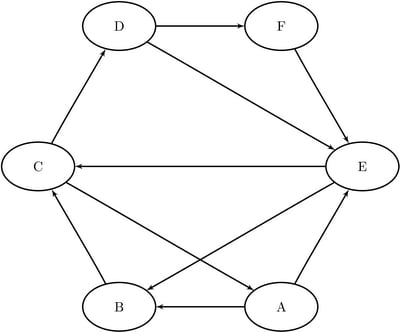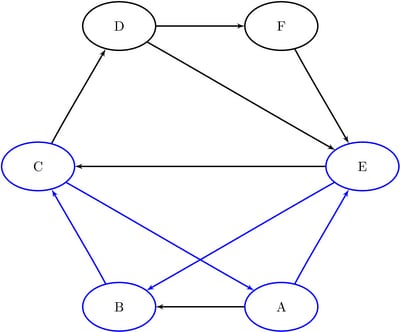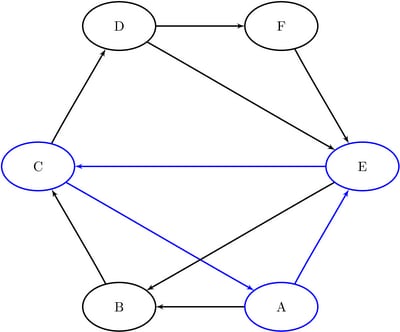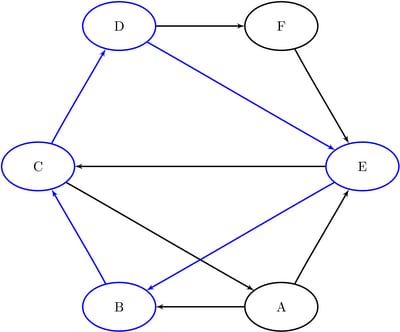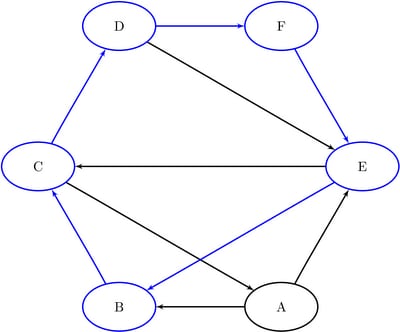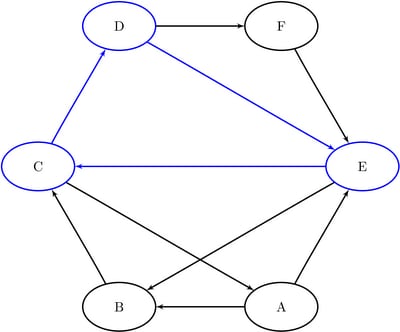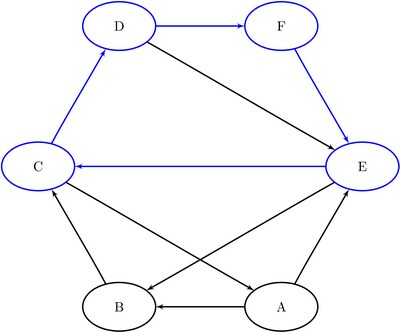The Network Solver (Experimental)
- Overview
- Getting Started
-
Syntax

-
Details
 Input Data for the Network SolverSolving over Subsets of Nodes and Links (Filters)Biconnected Components and Articulation PointsCliqueConnected ComponentsCycleLinear Assignment (Matching)Minimum-Cost Network FlowMinimum CutMinimum Spanning TreeShortest PathTransitive ClosureTraveling Salesman ProblemMacro Variable _OROPTMODEL_
Input Data for the Network SolverSolving over Subsets of Nodes and Links (Filters)Biconnected Components and Articulation PointsCliqueConnected ComponentsCycleLinear Assignment (Matching)Minimum-Cost Network FlowMinimum CutMinimum Spanning TreeShortest PathTransitive ClosureTraveling Salesman ProblemMacro Variable _OROPTMODEL_ -
Examples
 Articulation Points in a Terrorist NetworkCycle Detection for Kidney Donor ExchangeLinear Assignment Problem for Minimizing Swim TimesLinear Assignment Problem, Sparse Format versus Dense FormatMinimum Spanning Tree for Computer Network TopologyTransitive Closure for Identification of Circular Dependencies in a Bug Tracking SystemTraveling Salesman Tour through US Capital Cities
Articulation Points in a Terrorist NetworkCycle Detection for Kidney Donor ExchangeLinear Assignment Problem for Minimizing Swim TimesLinear Assignment Problem, Sparse Format versus Dense FormatMinimum Spanning Tree for Computer Network TopologyTransitive Closure for Identification of Circular Dependencies in a Bug Tracking SystemTraveling Salesman Tour through US Capital Cities - References
A path in a graph is a sequence of nodes, each of which has a link to the next node in the sequence. A cycle is a path in which the start node and end node are the same.
In the network solver, you can find the cycles (or just count the cycles) of an input graph by invoking the CYCLE= algorithm option. To find the cycles and report them in a set, use the CYCLES= suboption in the OUT= option. You do not need to use the CYCLES= suboption to simply count the cycles.
For undirected graphs, each link represents two directed links. For this reason, the following cycles are filtered out: trivial
cycles (![]() ) and duplicate cycles that are found by traversing a cycle in both directions (
) and duplicate cycles that are found by traversing a cycle in both directions (![]() and
and ![]() ).
).
The results for the cycle detection algorithm are written to the set that is specified in the CYCLES= suboption in the OUT= option. Each node of each cycle is listed in the CYCLES= set along with a cycle ID (the first argument of the tuple) to identify the cycle to which it belongs. The second argument of the tuple defines the order (sequence) of the node in the cycle.
The algorithm that the network solver uses to compute all cycles is a variant of the algorithm found in Johnson 1975. This algorithm runs in time ![]() , where
, where ![]() is the number of elementary cycles in the graph. So the algorithm should scale to large graphs that contain few cycles. However,
some graphs can have a very large number of cycles, so the algorithm might not scale.
is the number of elementary cycles in the graph. So the algorithm should scale to large graphs that contain few cycles. However,
some graphs can have a very large number of cycles, so the algorithm might not scale.
If MODE=ALL_CYCLES and there are many cycles, the CYCLES= set can become very large. It might be beneficial to check the number of cycles before you try to create the CYCLES= set. When you specify MODE=FIRST_CYCLE, the algorithm returns the first cycle it finds and stops processing. This should run relatively quickly. On large-scale graphs, the MINLINKWEIGHT= and MAXLINKWEIGHT= suboptions can be relatively expensive and might increase the computation time.
This section provides a simple example for using the cycle detection algorithm on the simple directed graph ![]() that is shown in Figure 8.29. Two other examples are Example 8.2 “Cycle Detection for Kidney Donor Exchange”, which shows the use of cycle detection for optimizing a kidney donor exchange, and Example 8.6 “Transitive Closure for Identification of Circular Dependencies in a Bug Tracking System”, which shows an application of cycle detection to dependencies between bug reports.
that is shown in Figure 8.29. Two other examples are Example 8.2 “Cycle Detection for Kidney Donor Exchange”, which shows the use of cycle detection for optimizing a kidney donor exchange, and Example 8.6 “Transitive Closure for Identification of Circular Dependencies in a Bug Tracking System”, which shows an application of cycle detection to dependencies between bug reports.
The directed graph ![]() can be represented by the following links data set
can be represented by the following links data set LinkSetIn:
data LinkSetIn; input from $ to $ @@; datalines; A B A E B C C A C D D E D F E B E C F E ;
The following statements check whether the graph has a cycle:
proc optmodel;
set<str,str> LINKS;
read data LinkSetIn into LINKS=[from to];
set<num,num,str> CYCLES;
solve with NETWORK /
graph_direction = directed
links = (include=LINKS)
cycle = (mode=first_cycle)
;
quit;
The result is written to the log of the procedure, as shown in Figure 8.30.
Figure 8.30: Network Solver Log: Check the Existence of a Cycle in a Simple Directed Graph
| NOTE: There were 10 observations read from the data set WORK.LINKSETIN. |
| NOTE: The experimental Network solver is used. |
| NOTE: The number of nodes in the input graph is 6. |
| NOTE: The number of links in the input graph is 10. |
| NOTE: Processing cycle detection. |
| NOTE: The graph does have a cycle. |
| NOTE: Processing cycle detection used 0.00 (cpu: 0.00) seconds. |
The following statements count the number of cycles in the graph:
proc optmodel;
set<str,str> LINKS;
read data LinkSetIn into LINKS=[from to];
set<num,num,str> CYCLES;
solve with NETWORK /
graph_direction = directed
links = (include=LINKS)
cycle = (mode=all_cycles)
;
quit;
The result is written to the log of the procedure, as shown in Figure 8.31.
Figure 8.31: Network Solver Log: Count the Number of Cycles in a Simple Directed Graph
| NOTE: There were 10 observations read from the data set WORK.LINKSETIN. |
| NOTE: The experimental Network solver is used. |
| NOTE: The number of nodes in the input graph is 6. |
| NOTE: The number of links in the input graph is 10. |
| NOTE: Processing cycle detection. |
| NOTE: The graph has 7 cycles. |
| NOTE: Processing cycle detection used 0.00 (cpu: 0.00) seconds. |
The following statements return the first cycle found in the graph:
proc optmodel;
set<str,str> LINKS;
read data LinkSetIn into LINKS=[from to];
set<num,num,str> CYCLES;
solve with NETWORK /
graph_direction = directed
links = (include=LINKS)
cycle = (mode=first_cycle)
out = (cycles=CYCLES)
;
put CYCLES;
create data Cycles from [cycle order node]=CYCLES;
quit;
The data set Cycles now contains the first cycle found in the input graph; it is shown in Figure 8.32.
The first cycle found in the input graph is shown graphically in Figure 8.33.
The following statements return all of the cycles in the graph:
proc optmodel;
set<str,str> LINKS;
read data LinkSetIn into LINKS=[from to];
set<num,num,str> CYCLES;
solve with NETWORK /
graph_direction = directed
links = (include=LINKS)
cycle = (mode=all_cycles)
out = (cycles=CYCLES)
;
put CYCLES;
create data Cycles from [cycle order node]=CYCLES;
quit;
The data set Cycles now contains all of the cycles in the input graph; it is shown in Figure 8.34.
Figure 8.34: All Cycles in a Simple Directed Graph
| cycle | order | node |
|---|---|---|
| 1 | 1 | A |
| 1 | 2 | B |
| 1 | 3 | C |
| 1 | 4 | A |
| 2 | 1 | A |
| 2 | 2 | E |
| 2 | 3 | B |
| 2 | 4 | C |
| 2 | 5 | A |
| 3 | 1 | A |
| 3 | 2 | E |
| 3 | 3 | C |
| 3 | 4 | A |
| 4 | 1 | B |
| 4 | 2 | C |
| 4 | 3 | D |
| 4 | 4 | E |
| 4 | 5 | B |
| 5 | 1 | B |
| 5 | 2 | C |
| 5 | 3 | D |
| 5 | 4 | F |
| 5 | 5 | E |
| 5 | 6 | B |
| 6 | 1 | E |
| 6 | 2 | C |
| 6 | 3 | D |
| 6 | 4 | E |
| 7 | 1 | E |
| 7 | 2 | C |
| 7 | 3 | D |
| 7 | 4 | F |
| 7 | 5 | E |
The six additional cycles are shown graphically in Figure 8.35 through Figure 8.37.
